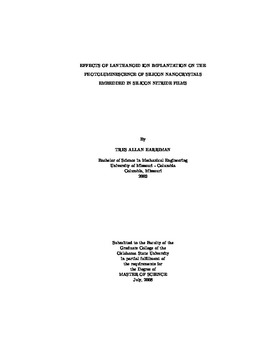| dc.contributor.advisor | Lucca, Don A. | |
| dc.contributor.author | Harriman, Tres Allan | |
| dc.date.accessioned | 2014-04-17T19:52:29Z | |
| dc.date.available | 2014-04-17T19:52:29Z | |
| dc.date.issued | 2008-07-01 | |
| dc.identifier.uri | https://hdl.handle.net/11244/9943 | |
| dc.description.abstract | A study on the effects of lanthanoid ion implantation on the optical behavior of Si nanocrystals synthesized in 200 nm thick amorphous SiN x films has been performed. The Si nanocrystals were fabricated using plasma enhanced chemical vapor deposition (PECVD) on (100) Si substrates. By regulating the flow rate of reactant gases, Ar-diluted SiH 4 and N 2 , the resulting nanocrystal size could be controlled. The synthesized films were investigated by photoluminescence (PL) spectroscopy and Raman spectroscopy.Due to quantum confinement effects the three different sizes of Si nanocrystals investigated, 2.6, 3.0, and 3.9 nm, had PL emissions of 2.85, 2.48, and 1.97 eV, respectively. The Si:SiN x films were subsequently implanted with lanthanoid ions and finally heat treated to reduce implantation damage. Specific ions used in this study were Ce 2+ , Eu 2+ , Tb 2+ , and Nd 2+ , all with incident energies of 63 keV and a fluence of 1x10 15 ions/cm 2 .In the as-implanted films, Ce 3+ ions led to an increase in the PL intensity of the small and medium nanocrystals. This behavior was not observed for the other ion species. After each of the two independent heat treatment cycles, the Ce-doped small particles showed further intensified PL emission, while the emission from the Ce-doped medium particle emission blue-shifted.The observed PL intensity increase and blue shifting from the Si nanocrystals appears to result from an energy transfer from Ce ions to the Si nanocrystals that is dependent upon the nanocrystal size, with energy being preferentially transferred to smaller Si nanocrystals. The exact nature of the transfer mechanism requires further study.A follow up investigation examined the effect of Ce ion fluence on the PL response of the Si nanocrystals. As the fluence increased from 3x10 19 , to 5x10 20 , and to 1x10 26 ions/cm 2 , the smallest particles showed a continual PL intensity increase, the medium particles showed an increase for the first two fluences and a decrease for the highest fluence, and the largest particles showed a continual decrease in PL intensity. This behavior is attributed to concentration quenching effects. | |
| dc.format | application/pdf | |
| dc.language | en_US | |
| dc.publisher | Oklahoma State University | |
| dc.rights | Copyright is held by the author who has granted the Oklahoma State University Library the non-exclusive right to share this material in its institutional repository. Contact Digital Library Services at lib-dls@okstate.edu or 405-744-9161 for the permission policy on the use, reproduction or distribution of this material. | |
| dc.title | Effects of Lanthanoid Ion Implantation on The Photoluminescence of Silicon Nanocrystals Embedded in Silicon Nitride Films | |
| dc.type | text | |
| dc.contributor.committeeMember | Price, C. Eric | |
| dc.contributor.committeeMember | Komanduri, Ranga | |
| osu.filename | Harriman_okstate_0664M_2860.pdf | |
| osu.college | Engineering, Architecture, and Technology | |
| osu.accesstype | Open Access | |
| dc.description.department | Mechanical & Aerospace Engineering | |
| dc.type.genre | Thesis | |
| dc.subject.keywords | photoluminescence | |
| dc.subject.keywords | silicon nanocrystals | |
| dc.subject.keywords | silicon nitride | |
| dc.subject.keywords | ion implantation | |
| dc.subject.keywords | lanthanoid | |
| dc.subject.keywords | energy transfer | |
